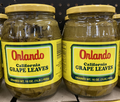 Merchant selling grape leaves in Damascus (2008) | |
Grape leaves, the leaves of the grapevine plant, are used in the cuisines of a number of cultures. They may be obtained fresh, or preserved in jars or cans. [1] [2] The leaves are commonly rolled or stuffed with mixtures of meat and rice to produce dolma (often, sarma), found widely in the Mediterranean, Caucasus, Balkans, and Middle East. [3] They may also be used in various other recipes and dishes. [4] When cut into smaller pieces they are used as a savory addition to soups that include greens and cabbage. [5]


